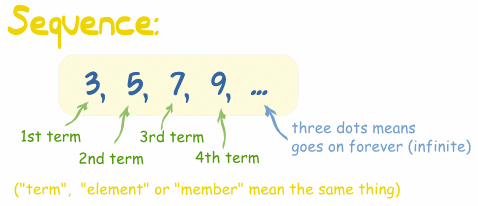Sequences
You can read a gentle introduction to Sequences in Common Number Patterns.
What is a Sequence?
A Sequence is a list of things (usually numbers) that are in order.
 |
Infinite or Finite
When the sequence goes on forever it is called an infinite sequence,
otherwise it is a finite sequence
otherwise it is a finite sequence
In Order
When we say the terms are "in order", we are free to define what order that is! They could go forwards, backwards ... or they could alternate ... or any type of order we want!
Like a Set
A Sequence is like a Set, except:
- the terms are in order (with Sets the order does not matter)
- the same value can appear many times (only once in Sets)
Notation
| Sequences also use the same notation as sets: list each element, separated by a comma, and then put curly brackets around the whole thing. | {3, 5, 7, ...} |
The curly brackets { } are sometimes called "set brackets" or "braces".
A Rule
A Sequence usually has a Rule, which is a way to find the value of each term.
As a Formula
Saying "starts at 3 and jumps 2 every time" is fine, but it doesn't help us calculate the:
- 10th term,
- 100th term, or
- nth term, where n could be any term number we want.
So, we want a formula with "n" in it (where n is any term number).
So, What Can A Rule For {3, 5, 7, 9, ...} Be?
Firstly, we can see the sequence goes up 2 every time, so we can guess that a Rule is something like "2 times n" (where "n" is the term number). Let's test it out:
Test Rule: 2n
| n | Term | Test Rule |
|---|---|---|
| 1 | 3 | 2n = 2×1 = 2 |
| 2 | 5 | 2n = 2×2 = 4 |
| 3 | 7 | 2n = 2×3 = 6 |
That nearly worked ... but it is too low by 1 every time, so let us try changing it to:
Test Rule: 2n+1
| n | Term | Test Rule |
|---|---|---|
| 1 | 3 | 2n+1 = 2×1 + 1 = 3 |
| 2 | 5 | 2n+1 = 2×2 + 1 = 5 |
| 3 | 7 | 2n+1 = 2×3 + 1 = 7 |
That Works!
So instead of saying "starts at 3 and jumps 2 every time" we write this:
2n+1
Many Rules
But mathematics is so powerful we can find more than one Rule that works for any sequence.
So it is best to say "A Rule" rather then "The Rule" (unless we know it is the right Rule).
Notation
To make it easier to use rules, we often use this special style:
 |
|
So a rule for {3, 5, 7, 9, ...} can be written as an equation like this:
xn = 2n+1
And to calculate the 10th term we can write:
x10 = 2n+1 = 2×10+1 = 21
Can you calculate x50 (the 50th term) doing this?
Here is another example:
Special Sequences
Now let's look at some special sequences, and their rules.
Arithmetic Sequences
In an Arithmetic Sequence the difference between one term and the next is a constant.
In other words, we just add some value each time ... on to infinity.
In General we can write an arithmetic sequence like this:
{a, a+d, a+2d, a+3d, ... }
where:
- a is the first term, and
- d is the difference between the terms (called the "common difference")
And we can make the rule:
xn = a + d(n-1)
(We use "n-1" because d is not used in the 1st term).

Good explanation and easy to understand! thanks!
BalasPadam